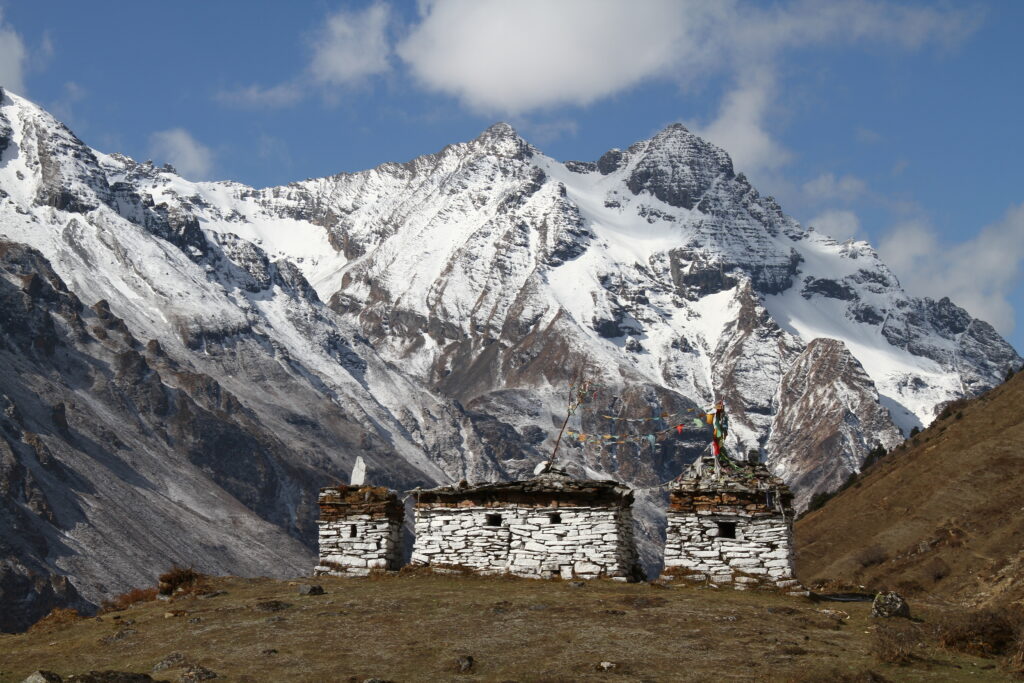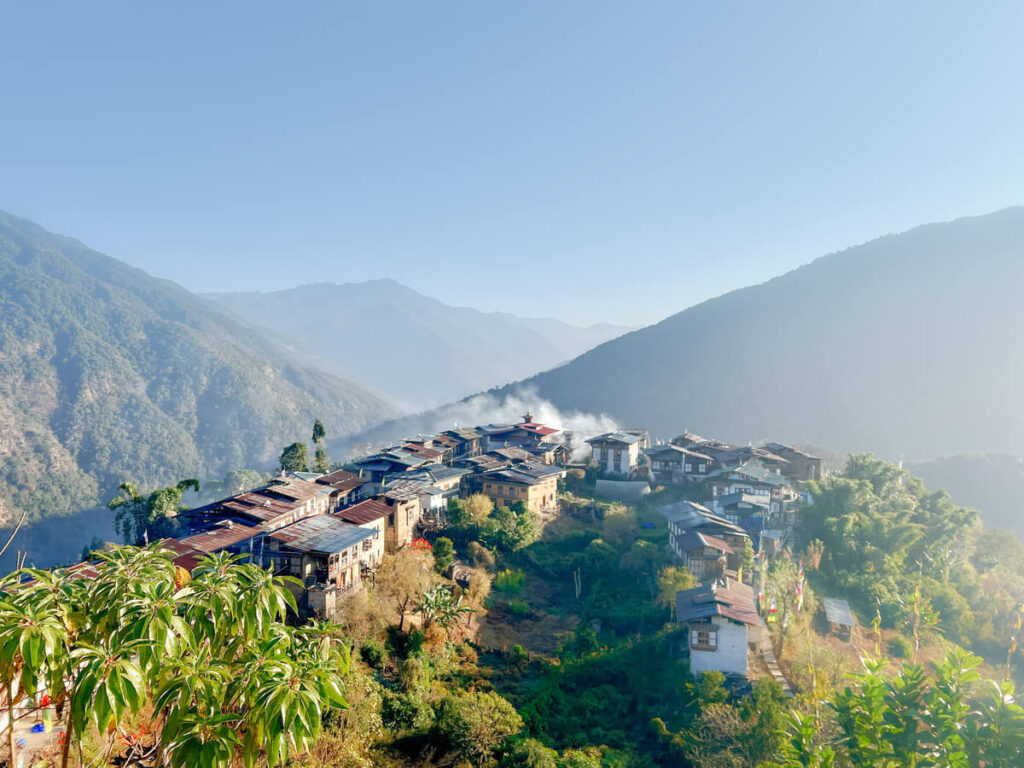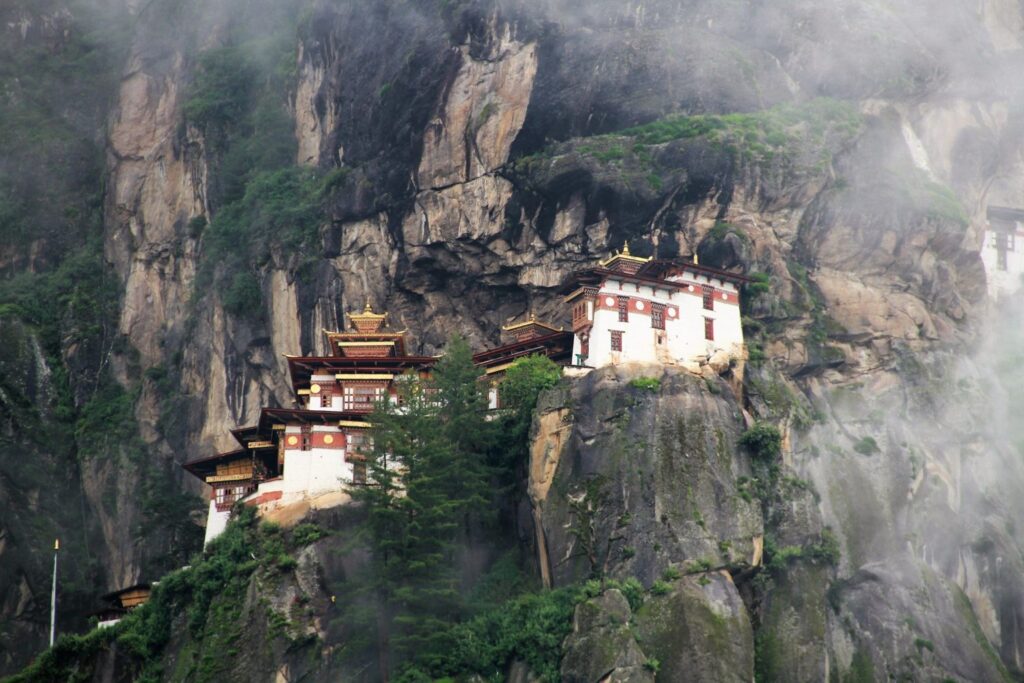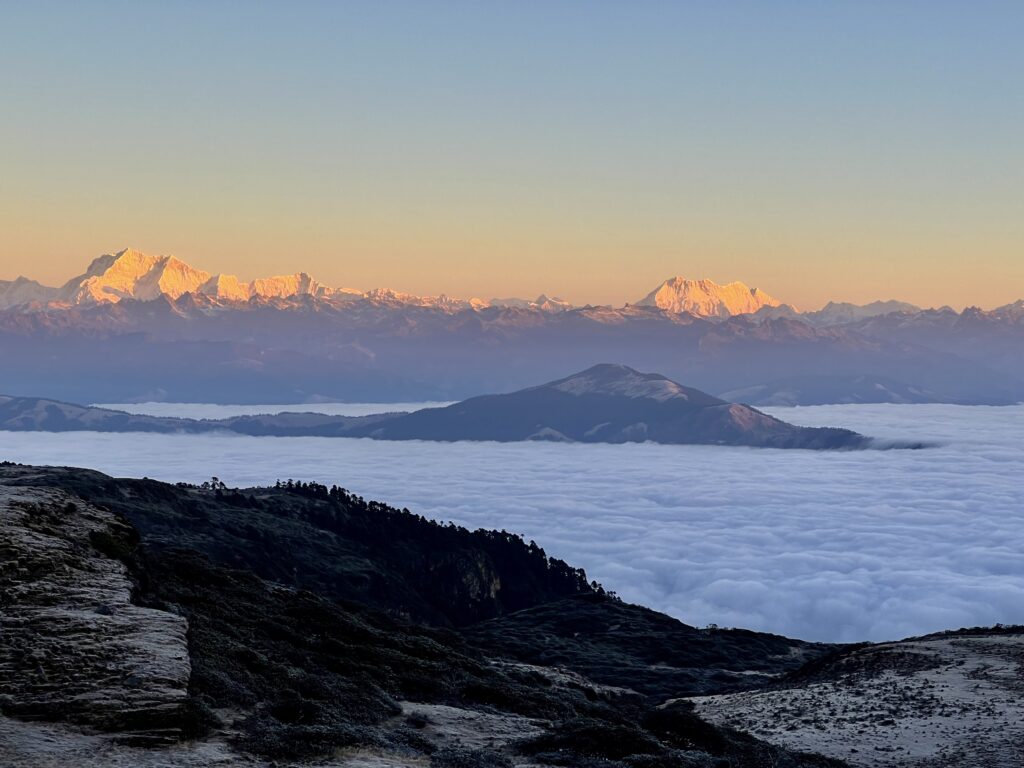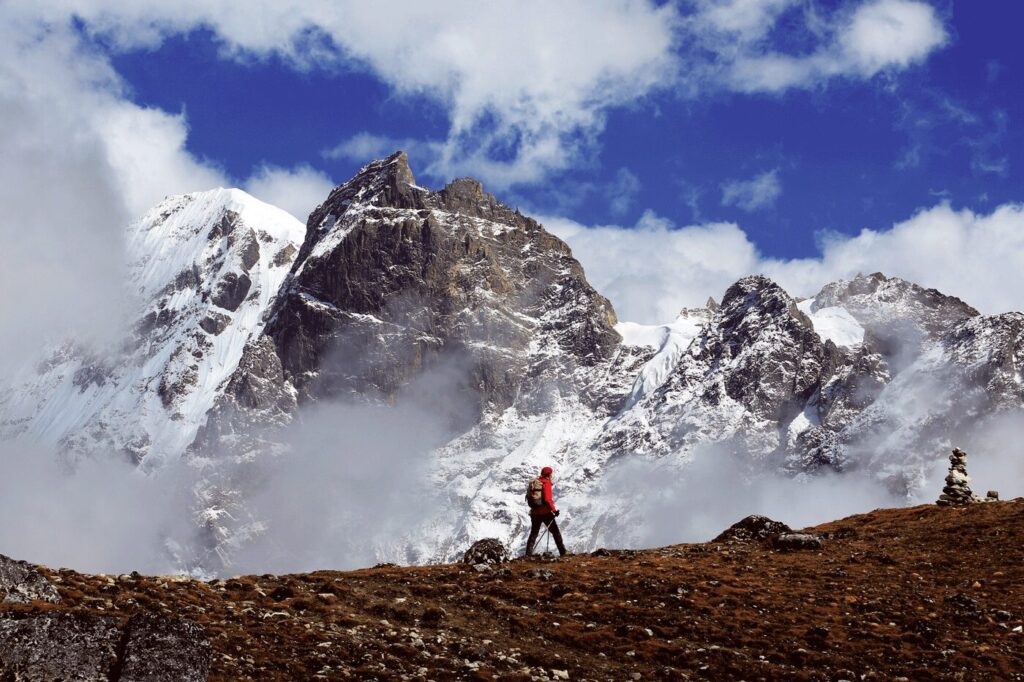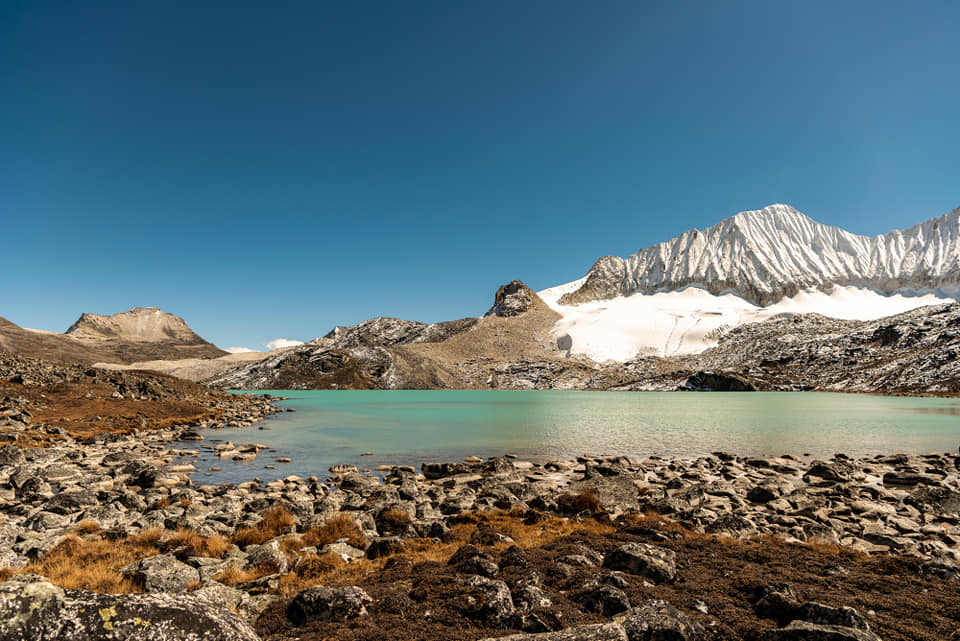Day 01: Arrival in Paro
Upon landing in Paro, you can enjoy the view of snowy Himalayan mountain peaks from above – a very unique scene of Bhutan. After meeting up with your guide and a short rest, we will begin exploring the beautiful Paro valley at an altitude of 2,300m.
Built in 1644 and praised as a fine example of Bhutanese architecture, Paro Rinpung Dzong (Fortress of the Heap of Jewels) is recognized for its massive buttressed walls. Now they house monk bodies and administrative offices of Paro in the dzong. The dzong also has fine wall paintings lining its inner courtyard, illustrating Buddhist lore like the wheel of life and scenes from the life of Milapera. With its huge walls, people say the dzong is visible throughout the valley.
Next, we will visit the National Museum of Bhutan (Ta Dzong), known for its conch-shell circular construction. It was built in 1649 to protect Paro Dzong. The extensive collection of the museum includes antique thangka paintings, textiles, weapons and armour, household objects and a rich assortment of natural and historic artifacts.
We will spend the night at the hotel in Paro.
Day 02: Paro sightseeing
We will spend the day hiking to see one of the holiest sites of Bhutan – Taktsang Monastery, or the Tiger’s Nest (3,120m). Legend says that Guru Rinpoche (who had ‘brought’ Buddhism to Bhutan), arrived on a tigress and meditated for three months here. The monastery perches on a cliff, and you can enjoy the enthralling view of the monastery from its cafeteria. Due to its unique location, we will be ascending for about 900m, and the 4.5km hike will take around 5-6 hours (for an average person). With multiple stops on the way, you will be able to indulge in the untouched nature and look out for the astonishing mountain scenery of Bhutan.
Then we will head to Kyichu Lhakhang, one of the 108 temples built in The Himalayas by Tibetan King, Songtsen Gampo in the 7th century. It is believed that he built the temple to pin down the left foot of a giant ogress who was obstructing the establishment of Buddhism in Tibet. Once you are here, you can catch the remarkable scene of elderly pilgrims shuffling around the temple and spinning its many prayer wheels.
Afterwards, we will stay for another night at the hotel in Paro.
Day 03: Paro – Jele Dzong
- Distance: 7-8km
- Estimated time: 4-5hrs
- Camp altitude: 3,480m
Today is the first day of our ‘Druk Path’ trek. The day will be quite tough since you will be ascending for about 1,090m. From Ta Dzong, we will be trailing through blue pine forests and a few farmhouses. From the ridge below Jele Dzong, we will descend about 100m to the campsite below the dzong.
Jele Dzong, though is mostly in ruins, is still an impressive fortress, located on top of the ridge and surrounded by colorful prayer flags. If the weather permits, you will have a great view of some mountains like Mt. Jomolhari (7,314 m) or Gangkhar Puensum (7,570 m).
Day 04: Jele Dzong – Jangchulakha
- Distance: 10km
- Estimated time: 4–5hrs
- Camp altitude: 3,770m
We will start with a steep hike for about 1.5 hours, then the trek will be more of a gradual ascent through thick lush alpine forests and rhododendron tresses. Following the trail, we will be ascending about 310m, and descending approximately 50m before we come to the campsite. You may catch the view of Mount. Jomolhari (7,314m) and the surrounding mountains, hear some pheasants calling during the day and see herders and their yaks around your campsite.
Day 05: Jangchulakha – Jimilang Tsho
- Distance: 11km
- Estimated time: 4hrs
- Camp altitude: 3,870m
Today our trek will ascend about 330m following the mountain ridge to a saddle at 4,040m, then a short descent back to Jangchu La Pass (4,180m). On a clear day, you can take in the magnificent view of Jimilang Tsho (Sand Ox Lake), known for its massive size trout, and Mount. Jitchu Drake (6,989m). The mountain peak represents the protective deity of Paro valley.
Day 06: Jimilang Tsho – Simkota Tsho
- Distance: 11km
- Estimated time: 4hrs
- Camp altitude: 4,110m
After passing through dwarf rhododendron trees and Janee Tsho Lake, we will continue ascending about 820m up to a ridge to reach Simkota Tsho. You may see some Bhutanese yak herders on the way and get a glimpse of a nomad’s life. your campsite will be close to Simkota Tsho Lake at 4,500m.
Day 07: Simkota Tsho – Phajoding
- Distance: 10km
- Estimated time: 3-4hrs
- Camp altitude: 3,750m
We will start the trek by ascending approximately 130m to a saddle at 4,180m and cross Phume La pass (4,210m). From the pass, you can spend some time to see beautiful prayer flags marking the pass and the stunning views of Mount Gangkhar Puensum (7,541m) and other Himalayan peaks. The trail then descends pass Thujidrag Goemba, a meditation centre hanging on the side of a precipitous rock face. We will continue further through juniper trees, and the campsite is located just above Phajoding Goemba (3,870m), an important pilgrimage site in Bhutan.
Day 08: Phajoding – Mothithang (Thimphu)
- Distance: 4-5km
- Estimated time: 2- 3hrs
After several days of ascent, the trek today will be all downhill through forested areas of mostly blue pines. The hike will take 2-3 hours with a total of 1,130m descent. At the end of the trek, we will arrive at the hotel in Thimphu by car.
In the afternoon, we will head to the National Memorial Chorten. This landmark was a monument to world peace and prosperity as per the idea of Bhutan’s Third King, His Majesty Jigme Dorji Wangchuck. The Tibetan-style shorten is the focus of many Bhutanese’s daily wordship.
Next stop is Buddha Point (Buddha Dordenma Statue), one of the most remarkable statues that you will ever see. It is the largest statue in Bhutan at a height of 51.5m, located on top of a hill in Kuenselphodrang Nature Park, overlooking the Southern entrance to Thimphu valley. The giant Buddha statue is said to emanate an aura of peace and happiness, and you can offer your prayers here.
The last visit today is Tashichho Dzong (Fortress of The Glorious Religion). It has been the seat of the Bhutan government since 1952 and now houses some of the most important rooms like the throne room and offices of the king. Other government departments are also located close to the dzong. First constructed in 1216 A.D, the dzong seats next to the bank of Wang Chhu river, close to the town of Thimphu.
At night, you can stroll around to see more of Thimphu and soak in the lively atmosphere of this charming city with crowded shops, bazaars and friendly locals in national Bhutanese dress.
You will stay overnight at the hotel in Thimphu.
Day 09: Thimphu to Punakha
- Altitude in Punakha: 1,300m
- Distance: 75km
- Estimated travel time: 3hrs
In the morning, we will be take- off from Thimphu to travel to Punakha. This town is the old capital of Bhutan. On the way, you can catch the beautiful 360degree panoramic view of the Himalayan range with snowcapped peaks from Dochula Pass. At 3,050m, this famous pass overlooks the Himalayas with 108 chortens (stupas) known as “Druk Wangyal Chortens’ ‘ and Druk Wangyal Lhakhang.
On arrival in Punakha, we will visit Punakha Dzong (Palace of Great Happiness). Built in 1637, this is commended as the most remarkable dzong in Bhutan. Punakha Dzong is not only the second oldest and second largest dzong but it also has one of the most majestic structures in the country. This spectacular construction is a symbol for a unified Bhutan, standing at the confluence of two rivers – the Pho Chhu and Mo Chhu. On sunny days, the sunlight reflecting off the river water onto the dzong’s white-washed huge walls is quite a sight for visitors to behold.
Passing the dzong, we will get to Pho Chhu Suspension Bridge, one of the longest of its kind in Bhutan with 160m in length. Looking out from the bridge, you will be rewarded with the wonderful scenery of Punakha Dzong and Pho Chhu valley.
After lunch, we will do an easy trek for about an hour to Khamsum Yuelley Namgyal Chorten, which stands majestically on a ridge above Punakha valley. With an altitude of 1500m and an elevation of 200m, this is a pleasant hike to take us through picturesque rice fields and pine trees. Praised as a splendid architectural icon of Bhutan and the only one of its kind, this temple was built by Her Majesty the Queen Mother to dedicate for the well-being of the whole kingdom. It is said that the best view of the whole Punakha valley can be seen from the top of this unique temple.
From the site, it will take approximately 30 minutes to hike down.
We will spend our night at the hotel in Punakha.
Day 10: Punakha to Paro
After breakfast, it is time to drive back to Paro. Then we will do an easy hike for 30 minutes to Chimi Lhakhang (Temple of Fertility) at an altitude of 1,500m. With an elevation of only about 20m, the trail will ascend slightly as we pass through farm lands of Lobesa Village. Along the way, you will have the chance to see local farmers at work. The best time to do this short trek is in the afternoon and you will reach the monastery in time when the monks there are doing evening prayer.
In the late afternoon, we can also have a nice walk around the main streets and market of Paro. You will spend the last night of the trip at the hotel in Paro.
Day 11: Depart Paro
After an early breakfast at the hotel, our guide will accompany you to the airport for flight to your onward destination. Tashi Delek (goodbye and good luck) and we hope to see you again!





